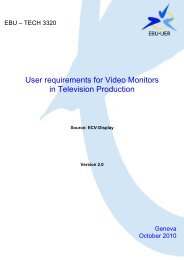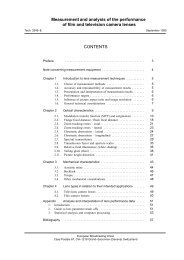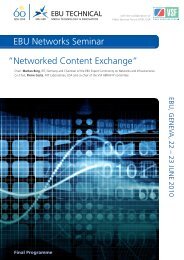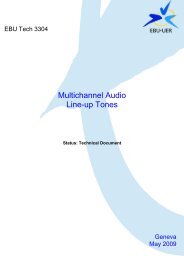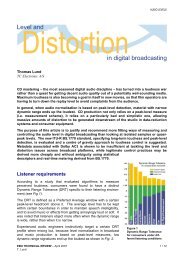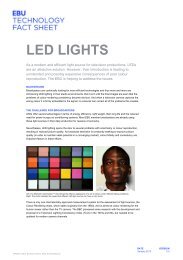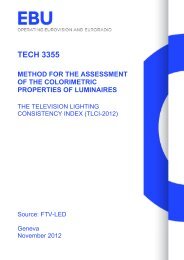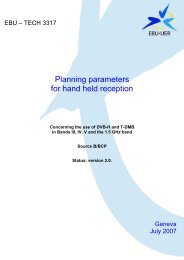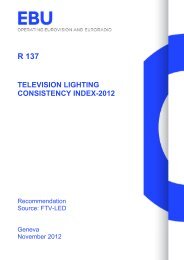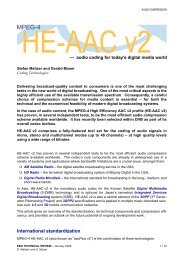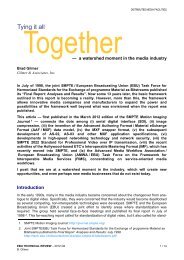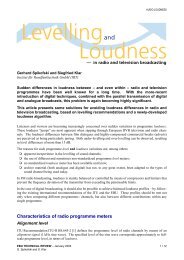Production Technology Seminar 2009 - EBU Technical
Production Technology Seminar 2009 - EBU Technical
Production Technology Seminar 2009 - EBU Technical
Create successful ePaper yourself
Turn your PDF publications into a flip-book with our unique Google optimized e-Paper software.
The <strong>EBU</strong> Recommendation R 124 12 , accessible to all publics, provides guidelines for the 'Choice of<br />
HDTV Compression Algorithm and Bit rate for Acquisition, <strong>Production</strong> and Distribution'.<br />
1.6 HDTV Distribution Encoder Tests Results<br />
Rainer Schaefer, Head of <strong>Production</strong> Systems TV, IRT, Germany<br />
The previous report of the P/HDC group work [4] was presented in January 2008 13 .<br />
For the tests, two sets of sequences were assembled from transparent sources and from the former<br />
P/HDTP group [6]-[7]+[20]. The parameters used for evaluation were:<br />
� Formats: 1920 x 1080i/25, 1440 x 1080i/25, 1280 x 720p/50<br />
� Bit-rates: 6 to 20 Mbit/s in steps of 2 Mbit/s<br />
� GOP structures (with an I-frame distance ~ 0,64 s): N16M3 for 1080i/25, N32M3 for 720p/50, and<br />
dynamic GOP enabled, if supported.<br />
The H.264 (MPEG-4 AVC) encoders used for evaluations, during two experts viewing sessions, were:<br />
Ateme Kyrion (status Q3/07), Harmonic Electra 7000 (status Q3/07), Scientific Atlanta D9054 (status<br />
Q3/07), Tandberg EN8090 (status Q3/07, and status Q2/08 optimised), GVG/Thomson Vibes EM3000<br />
(status end Q4/08). The state-of-the-art HD MPEG-2 encoder Sciatl D9050 was used as an anchor and<br />
reference. Three different tests were undertaken, with the following results:<br />
Test Tasks Test results<br />
Step 1<br />
Distribution only<br />
[12]+[17]<br />
Step 2<br />
Distribution only<br />
[13]+[18]<br />
Cascaded<br />
4th generation<br />
<strong>Production</strong><br />
+ Distribution<br />
[14] + [20]<br />
Identify critical sequences<br />
of the whole set of<br />
sequences and record<br />
general observations on<br />
H.264 encoder<br />
Find the bit-rate of device<br />
under test to match an<br />
"upper anchor“ (24 Mbit/s<br />
of the reference MPEG-2<br />
encoder).<br />
Identify whether<br />
production encoder<br />
stresses distribution<br />
encoder at low bit-rates<br />
and whether production<br />
encoder limits distribution<br />
quality at high bit-rates<br />
12 http://tech.ebu.ch/docs/r/r124.pdf<br />
13 Cf. <strong>Production</strong> <strong>Technology</strong> seminar 2008 report - § 2.5<br />
H.264 (MPEG-4 AVC) codecs are generally better than an MPEG-2 encoder<br />
operating at twice the bit-rate<br />
Generally less coding artefacts for AVC except for grass and diva<br />
On average MPEG-2 (at doubled bit-rate) & H.264 are comparable for<br />
critical scenes; just perceptible loss of resolution for some scenes in H.264<br />
depending on the codec optimisation<br />
Visible artefacts for sequences.... (Diva, Oly Flags...) at low bit-rates such as<br />
6..8 Mbit/s H.264<br />
Sometimes perceptible loss of sharpness for H.264 (one encoder, certain<br />
sequences...), depending on optimization of encoder<br />
Good sharpness in general...<br />
GOP pumping perceptible to very perceptible in some sequences (...)<br />
GOP pumping in sub-areas of certain sequences<br />
…<br />
According to the formats, the following average bit-rates of the 5 codecs<br />
tested were needed to match:<br />
1920 x 1080i/25: 12,833 Mbit/s (8 - 16 Mbit/s interval)<br />
1440 x 1080i/25: 12,133 Mbit/s (10 - 14 Mbit/s)<br />
1280 x 720p/50: 10,533 Mbit/s (8 - 14 Mbit/s)<br />
At high bit-rates:<br />
No significant impairments of production encoder and type of production<br />
encoder visible<br />
In some cases: It may be the case that the picture quality has improved<br />
for720p/50 in such a way that differences now become more visible<br />
At low bit-rates:<br />
Just perceptible loss of resolution at 3H vieving distance<br />
Just perceptible increase of coding artefacts at 3H<br />
GOP pumping in certain sub-areas of critical sequences<br />
Perceptible increase of noise for certain sequences<br />
In summary: no significant dependency on any production encoder!<br />
© <strong>EBU</strong> <strong>2009</strong> / <strong>Production</strong> <strong>Technology</strong> seminar / January 27 - 29, <strong>2009</strong><br />
Reproduction prohibited without written permission of <strong>EBU</strong> TECHNICAL & <strong>EBU</strong> TRAINING<br />
13



